Voices of Industry
The Oakland-based label is one of the rare few to use fiber farmed and spun in the US, then handwoven into true cotton shirts

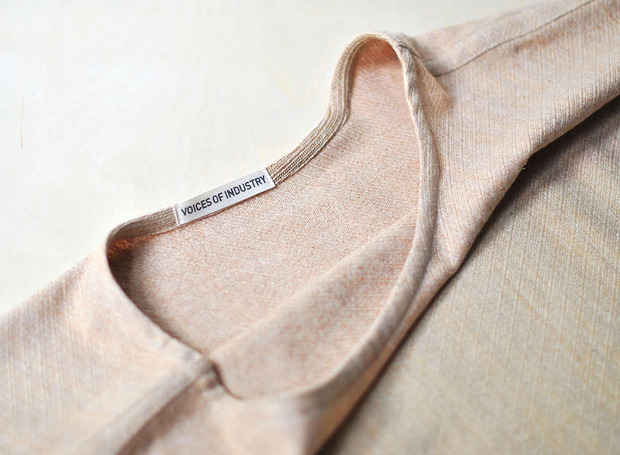
According to the American Apparel & Footwear Association report released last week, 97.5% of apparel sold in the United States is made internationally. For the past two years, this number has been in decline (albeit in the decimals) as the Made in USA movement gains more and more momentum, with consumers becoming aware of conditions overseas due to incidents—such as last year’s catastrophic garment factory collapse in Savar, Bangladesh. But in some cases, the phrase “Made in USA” can be misleading: Even if the labor is domestic, fabrics might have been dyed, woven or cut in foreign countries and there’s also the question of where materials such as threads or zippers are sourced.

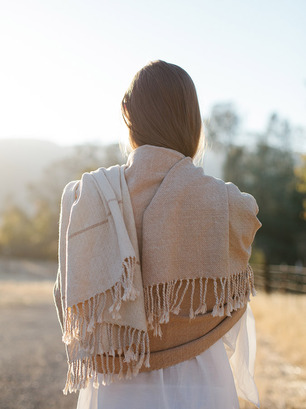
A brand can’t get any more transparent about their production than Oakland-based Voices of Industry (VOI), which is taking the plunge into creating bona fide American textiles and apparel. The new brand considers domestic farmers (whether they raise cotton or alpaca) to be the essential core of the making process; VOI sources domestic fiber that’s farmed and spun in the US, then hand-woven on a mechanical loom and finished by a pattern-maker and tailor. At a single glance at any VOI piece, the weaving process and the material’s agricultural origin is clearly visible within the patterned detail—but if you’re interested, information on the farmer who grew the fiber (as well as warp and loom order) is clearly recorded next to every piece.
The label was founded by Rhode Island School of Design alum Adele Stafford, who has experience in both craftsmanship (glassblowing and using a mechanical loom; she weaves each VOI piece) and business strategy, as she’s worked for well-known names like Boston’s Museum of Fine Arts and San Francisco design firm frog. Rather than many artisans who might depend on platforms like Etsy to sell their wares, Stafford has taken advantage of her unusual background to build a movement from scratch; to effectively share the stories of these independent farmers through her team’s work.

Stafford attended RISD in college to pursue glassblowing. “The glass program was a sculpture program, so we weren’t really there to make functional pieces of craft,” says Stafford. “It was really about thinking of glass as a very technically demanding medium with which to explore sculptural properties. I ended up moving away from glass within that time and working a lot with textiles.” True to RISD form and thinking outside of the box, Stafford’s senior thesis explored the themes of light and movement but through the mediums of fabric and cloth instead of glass.

Post-grad, Stafford spent a year working for Dale Chihuly on the hot shop floor as a part of his chandelier team in Seattle. “I credit that experience as my first foray into understanding production, design and manufacturing—and thinking about that both as it applies to technology and scale, and also as it can apply to handcrafted production.”
In a surprising move for an artisan, Stafford pursued business school in Boston and received an MBA, entering the non-profit art management world. She helped lead marketing strategy at the Museum of Fine Arts in Boston, but found herself frustrated by not being a maker.

As a form of release, she and her ex-husband bought and “rehabilitated” a derelict 1880s bank building in Woonsocket, Rhode Island. Stafford spent time learning about the house’s place in history due to its location along the Blackstone River, which had played a crucial role in the development of water-powered cotton mills during the Industrial Revolution. “That was the first time I read about Sarah Bagley, who had fled her family’s farm in New Hampshire at the height of the Industrial Revolution, like 1840s, to move to Lowell, Massachusetts to be a loom operative,” recalls Stafford. “At the time, women were being recruited by mill owners to come work the looms. And she ended up organizing the first all-women’s labor reform movement and became editor of a publication that outlined their vision, demands and outcry at the promises they’ve been made around cultural and educational advancement by moving to the big city. That publication is called ‘Voice of Industry.’ That’s where the name comes from.”
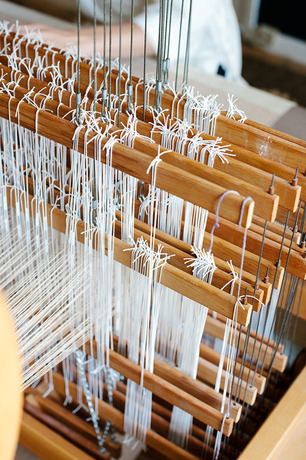
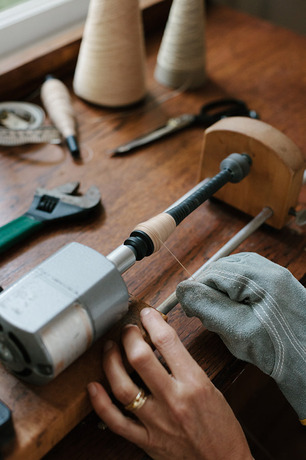
It was this interesting juxtaposition of being heavily embedded in the technology-design world, working with massive clients… and coming home every night and hand-sewing and knitting
Stafford landed on the West Coast around five years ago, and worked for the esteemed SF-based design firm frog for over three years on their business side while continuing to explore making. “It was this interesting juxtaposition of being heavily embedded in the technology-design world, working with massive clients like HP, Sony and Disney—and coming home every night and hand-sewing and knitting.” It was here when she was exposed to a network of fiber farmers in northern California who were growing both cotton as well as wool from sheep and alpaca.
“Because of the disappearance of the mill, there was such little opportunity being capitalized on, moving their work into product that was interesting, contemporary, thoughtful and told their story,” says Stafford. “Last year, I took the leap and left frog and decided to pursue weaving—as a production weaver—full time and put the farmer at the heart of the business model.” Voices of Industry was born.

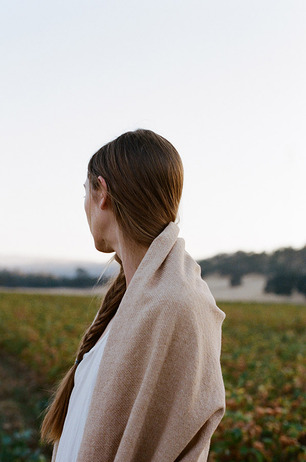
“I specifically seek out farmers who are doing something unique in terms of agricultural commitment whether that’s breeding excellence or an interesting biodynamic approach to farming. Small independent growers who are making beautiful product, but also in their process have something rich to add in terms of a story.” Voices of Industry’s first collaboration is with Sally Fox, a farmer based in northern California who breeds naturally colored cotton (which have been in existence for thousands of years), developing brown and green varieties into long spun cotton. Therefore, the VOI pieces are not dyed, but instead their color comes directly from the plant.

Voices of Industry isn’t just a sole woman on the loom; Stafford’s team includes a visual designer, a pattern-maker, a cut-and-sew person and two photographers. Stafford is in a unique position as she’s not only the designer and weaver, but with her strong business background, she had the experience to build a new brand from scratch and nurture its success. “If I’m having a crappy day at the loom and don’t feel like weaving, I can park it and work on brand development, story development and public relations.”
The way Stafford holds herself at the loom is akin to how a master pianist sits down at the bench. “The loom has its own story; it’s made by Ahrens & Violette Looms (AVL) and they are in Chico, California. They basically brought back an 1800s technology. Instead of using a bunch of pedals on the floor to control each harness, you program the loom through this very rudimentary system of bars and metal pegs to advance the weaving pattern. You use one pedal to advance the weaving pattern so it really goes much, much faster and there’s a lot less error because you’re not having to remember the dance steps of all of the different levers on the ground. It’s considered a true production loom; you don’t see them very often anymore, because that mechanical peg and bar system has been replaced by computers.” According to Stafford, only two companies make them—the other being a Dutch company, Louët.
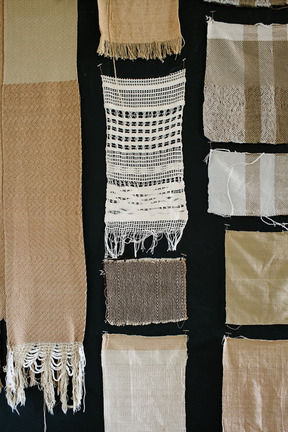
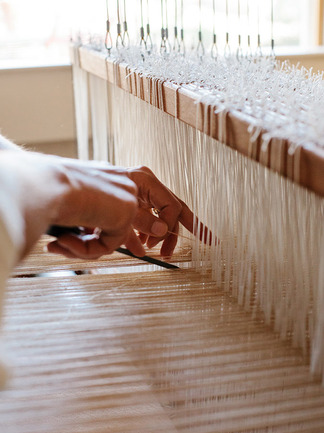
It takes Stafford at least three to four days to dress the loom. “I spend a whole day sitting inside of the loom, threading each heddle, one by one. In the shirts and the pieces of cloth, there are about 1100 threads on the warp going across, so it’s just a ton of manual labor. Once I’m weaving, I can do three-quarters to a yard per hour if everything is humming along—which is rare.” After a few hours of actual weaving, it gets wet-finished, then cut and sewed. VOI makes about 15-20 pieces a month.
“The upkeep is daily. That’s one of the things that people don’t really think about weaving and looms; I go through a daily checklist—making sure bolts are tightened down, springs are adjusted, levers get adjusted. It’s like an intimate relationship with any good tool you’re using; this partnership that we have where I have to pay attention to it every day. Also, when you’re weaving, crazy stuff happens, there are always little fine-tune adjustments you have to be making based on things like temperature, things expanding or contracting; it shows up very, very quickly in the woven work. So it’s constant maintenance.”
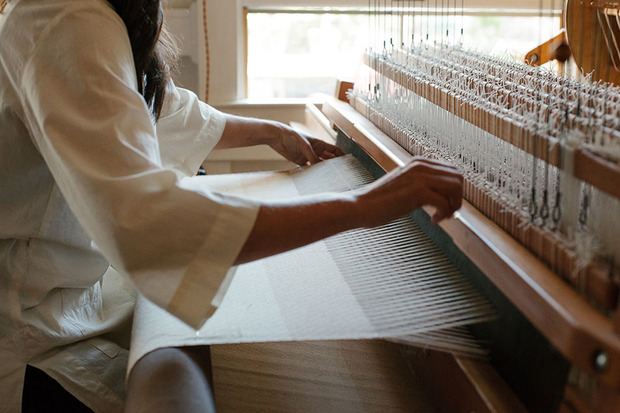
“The way that I’m approaching this work—we start with the warp on the loom as the beginning of our design process. So I’m not just weaving a bolt of cloth and going to cut it up; it’s more specific than that. There is a history of garments throughout time and cultures that are designed from the loom; so, this is nothing new—where people look at the shape and constraints of the warp and maximize the use of cloth. For example, the shirts and the finished piece of cloth were woven on the same warp. We’re about to do another warp where a dress, a skirt and a pillow are all going to share the same warp. So we’re thinking through those dimensions as constraints and getting smart about our design process.”
“it’s a combination of the constraints of the machine and process, honoring material, and historical and artistic reference”
And like any good designer or artist, Voices of Industry is inspired by outside influences, especially modernist design. “I’m heavily influenced by folks like Anni Albers, Sheila Hicks and Agnes Martin. Looking at those visual design references as well as traditional textile makers like Harris Tweed in Scotland or Swan’s Island in Maine. I would say it’s a combination of the constraints of the machine and process, honoring material, and historical and artistic reference.”

On her own wardrobe, Stafford says, “I try my very hardest to make a fundamental commitment to domestic textile makers and designers. So I wear brands that are mostly made in the USA—hopefully, made of cloth that’s produced in the USA—but that is really, really next to impossible to find.” Aside from her own label, the only other maker that Stafford knows that does similar work is Alabama Chanin, who hand-sews pieces from recycled materials and organic cotton grown mostly in Texas. While other designers don’t use domestic-made cloth, she still appreciates brands like Black Crane, Jungmaven, or local designers like Erica Tanov or Small Trade Company in San Francisco, which all do production in the US.
One brand that has made a particularly big influence on Stafford, however, is Cobra Rock Boot company, known for their waiting list that can take around six to eight months due to their handmade process. “I really admire them so much, I admire the handcraft nature of their work, the product is exquisite, but it’s also extremely distilled. So I sort of took a cue from them… Getting to know what you do really well, and being OK with doing a few things beautifully, really well—I aspire to that.”
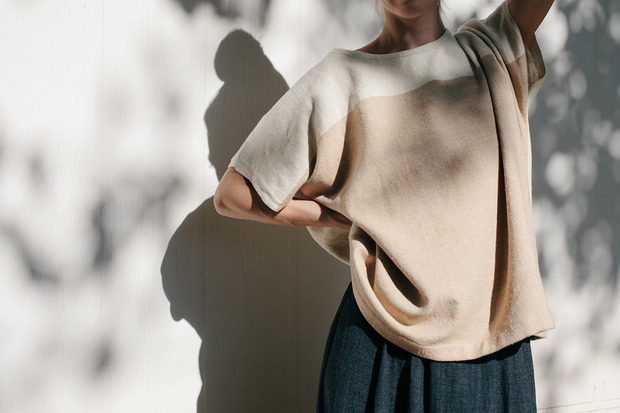
View the collection at Voices of Industry’s online store. Due to the time it takes to produce each piece, don’t be dissuaded by the Sold Out signs but reach out to Stafford and inquire when she will upload her next batch of apparel and textiles, fresh off the loom. Later in the year, Voices of Industry will be developing a collection with an alpaca farmer based in North Carolina.
Lifestyle and studio images courtesy of Brian Ferry, product images courtesy of Adele Stafford and Valeda Beach Stull









